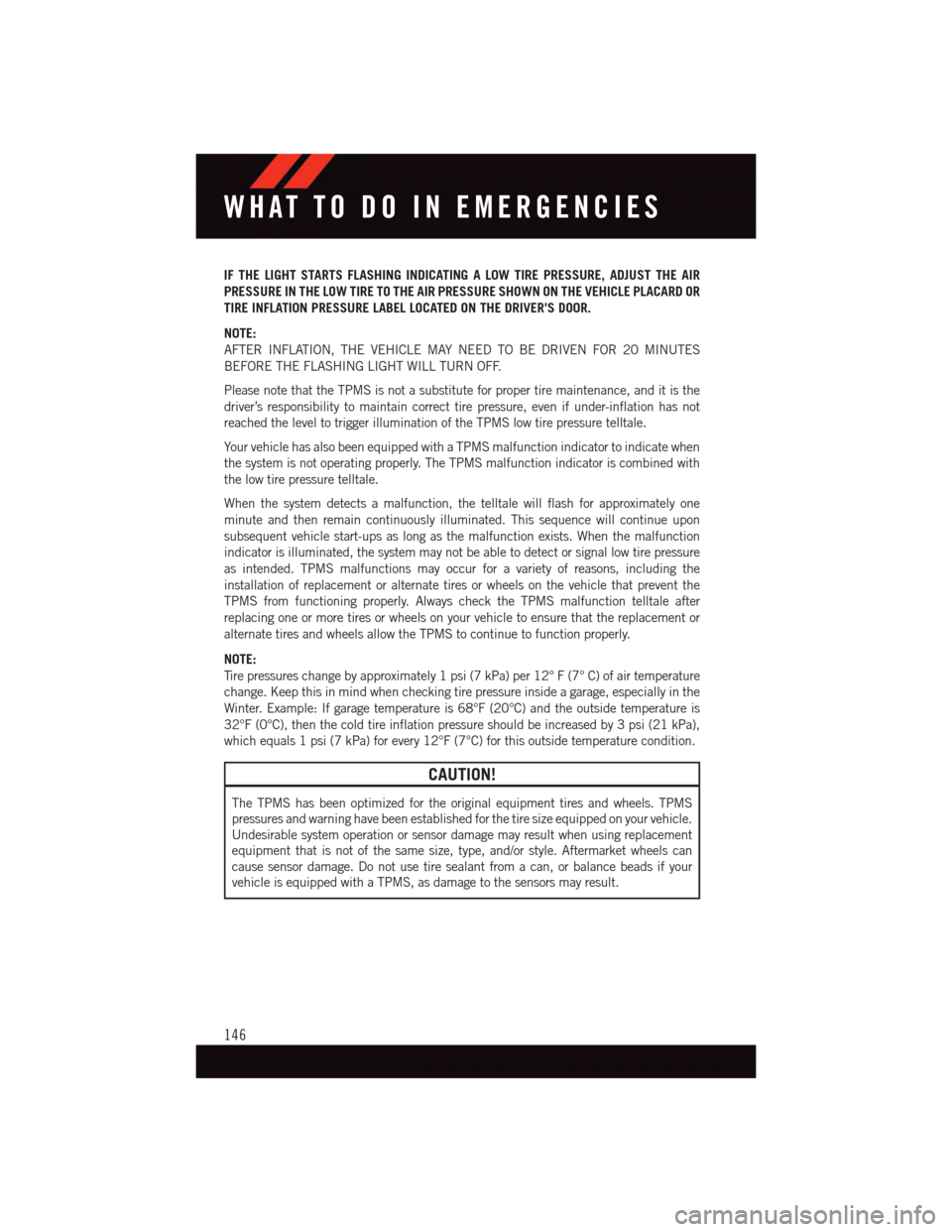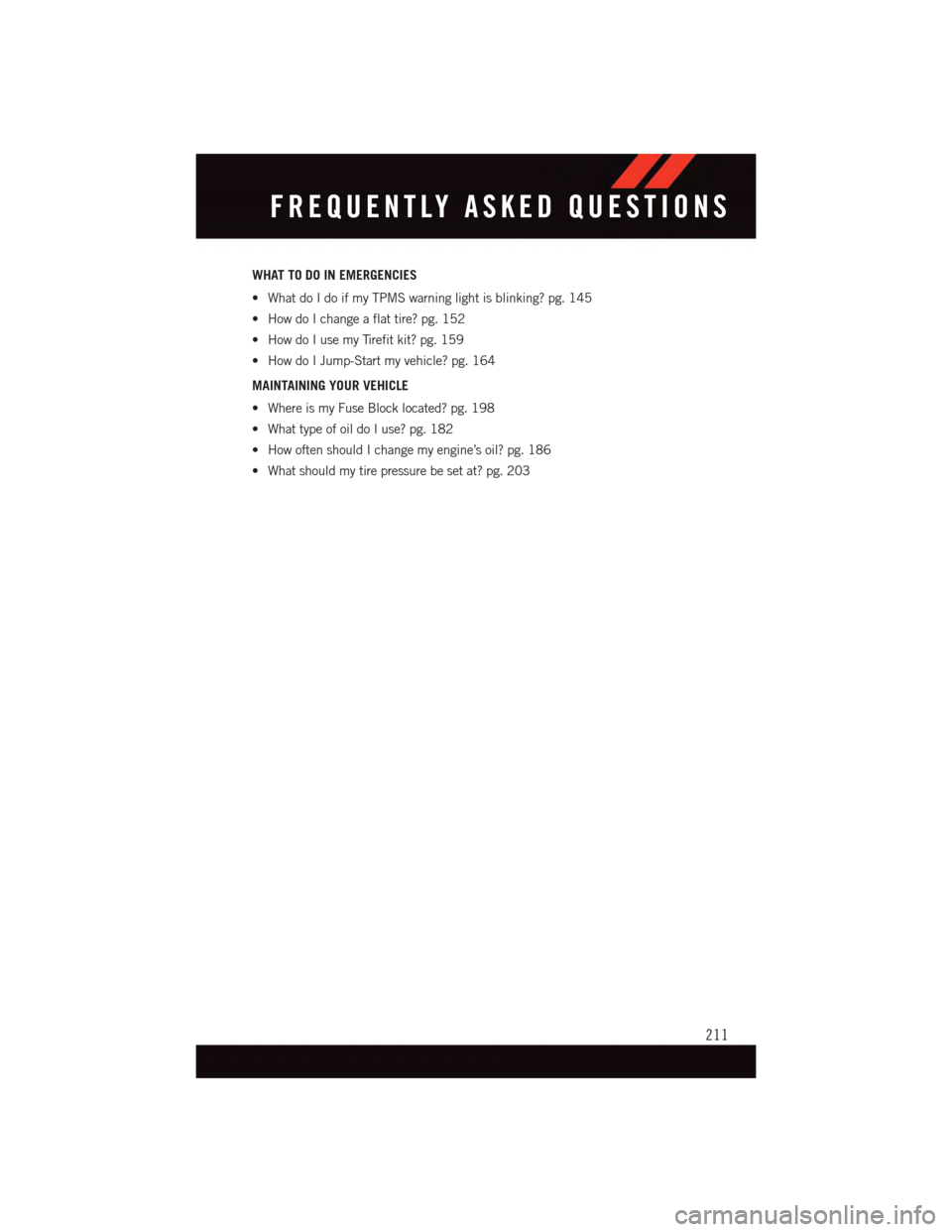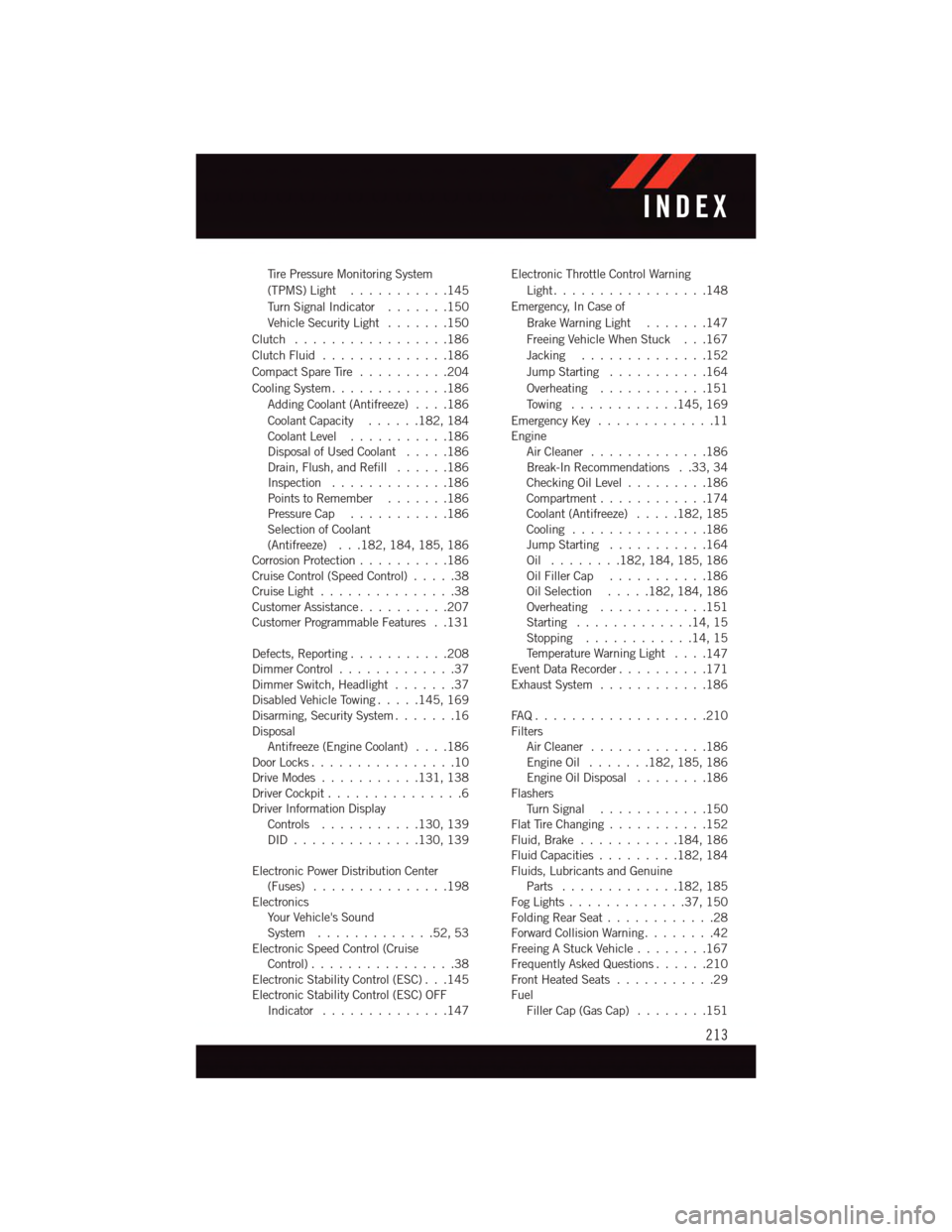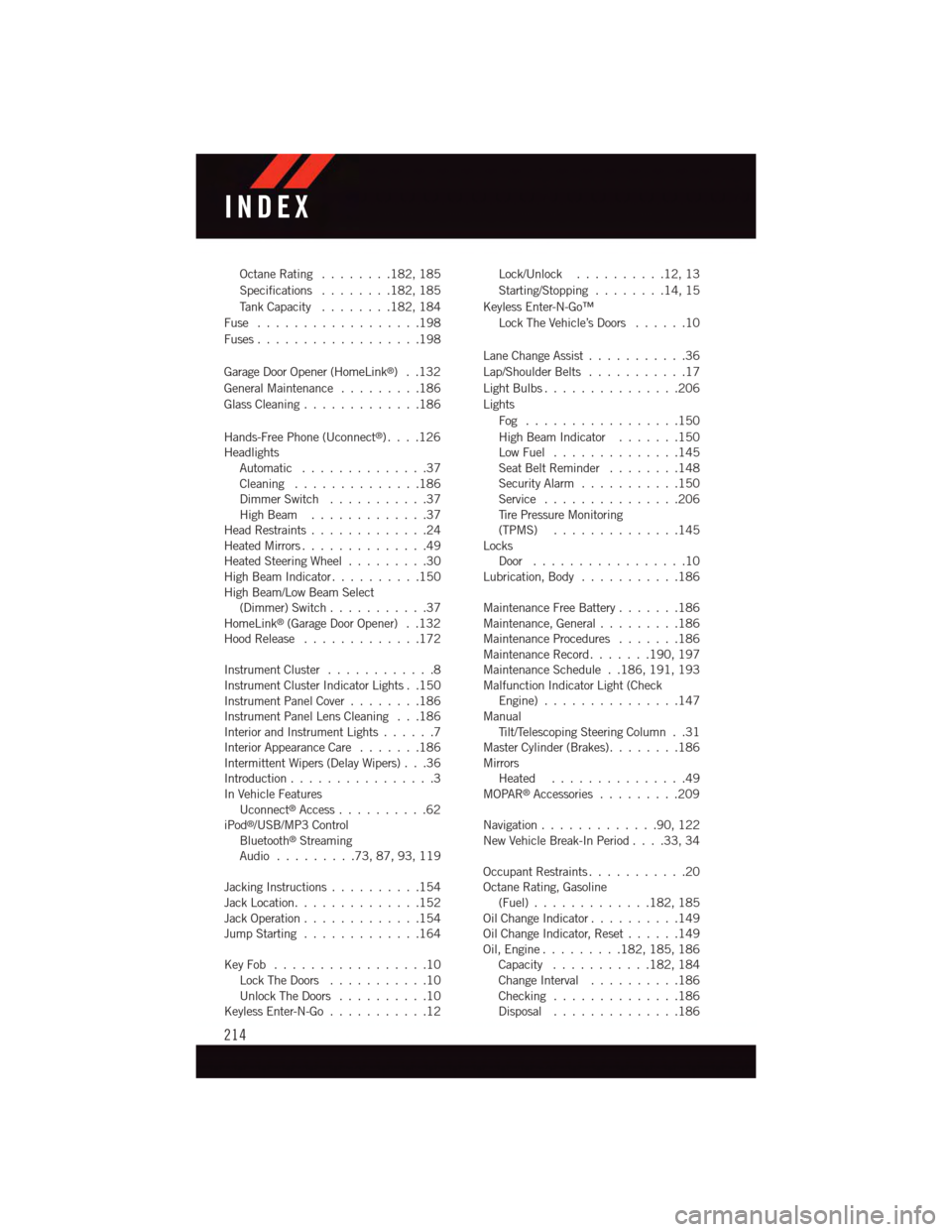TPMS DODGE CHALLENGER 2015 3.G User Guide
[x] Cancel search | Manufacturer: DODGE, Model Year: 2015, Model line: CHALLENGER, Model: DODGE CHALLENGER 2015 3.GPages: 220, PDF Size: 30.96 MB
Page 147 of 220

ROADSIDE ASSISTANCE
Dial toll-free 1-800-521-2779 for U.S. Residents or 1-800-363-4869 for Canadian
Residents.
•Provideyourname,vehicleidentificationnumber,licenseplatenumber,andyour
location, including the telephone number from which you are calling.
•Brieflydescribethenatureoftheproblemandanswerafewsimplequestions.
•Youwillbegiventhenameoftheserviceproviderandanestimatedtimeofarrival.If
you feel you are in an “unsafe situation”, please let us know. With your consent, we will
contact local police or safety authorities.
INSTRUMENT CLUSTER WARNING LIGHTS
-LowFuelWarningLight
This warning light indicates when the fuel level reaches approximately 2.0 gal (7.8 L), this
light will turn on and a single chime will sound.
-ElectronicStabilityControl(ESC)Activation/MalfunctionIndicatorLight
The “ESC Activation/Malfunction Indicator Light” in the instrument cluster will come on
when the ignition switch is turned to the ON/RUN position. It should go out with the
engine running. If the “ESC Activation/Malfunction Indicator Light” comes on continu-
ously with the engine running, a malfunction has been detected in the ESC system.
If this light remains on after several ignition cycles, and the vehicle has been driven
several miles (kilometers) at speeds greater than 30 mph (48 km/h), we recommend you
drive to the nearest service center and have the vehicle serviced immediately.
-TirePressureMonitoringSystem(TPMS)Light
Each tire, including the spare (if provided), should be checked monthly when cold and
inflated to the inflation pressure recommended by the vehicle manufacturer on the
vehicle placard or tire inflation pressure label. (If your vehicle has tires of a different size
than the size indicated on the vehicle placard or tire inflation pressure label, you should
determine the proper tire inflation pressure for those tires.)
As an added safety feature, your vehicle has been equipped with a tire pressure
monitoring system (TPMS) that illuminates a low tire pressure telltale when one or more
of your tires is significantly under-inflated. Accordingly, when the low tire pressure telltale
illuminates, you should stop and check your tires as soon as possible, and inflate them to
the proper pressure. Driving on a significantly under-inflated tire causes the tire to
overheat and can lead to tire failure. Under-inflation also reduces fuel efficiency and tire
tread life, and may affect the vehicle’s handling and stopping ability.
WHAT TO DO IN EMERGENCIES
145
Page 148 of 220

IF THE LIGHT STARTS FLASHING INDICATING A LOW TIRE PRESSURE, ADJUST THE AIR
PRESSURE IN THE LOW TIRE TO THE AIR PRESSURE SHOWN ON THE VEHICLE PLACARD OR
TIRE INFLATION PRESSURE LABEL LOCATED ON THE DRIVER'S DOOR.
NOTE:
AFTER INFLATION, THE VEHICLE MAY NEED TO BE DRIVEN FOR 20 MINUTES
BEFORE THE FLASHING LIGHT WILL TURN OFF.
Please note that the TPMS is not a substitute for proper tire maintenance, and it is the
driver’s responsibility to maintain correct tire pressure, even if under-inflation has not
reached the level to trigger illumination of the TPMS low tire pressure telltale.
Yo u r v e h i c l e h a s a l s o b e e n e q u i p p e d w i t h a T P M S m a l f u n c t i o n i n d i c a t o r t o i n d i c a t e w h e n
the system is not operating properly. The TPMS malfunction indicator is combined with
the low tire pressure telltale.
When the system detects a malfunction, the telltale will flash for approximately one
minute and then remain continuously illuminated. This sequence will continue upon
subsequent vehicle start-ups as long as the malfunction exists. When the malfunction
indicator is illuminated, the system may not be able to detect or signal low tire pressure
as intended. TPMS malfunctions may occur for a variety of reasons, including the
installation of replacement or alternate tires or wheels on the vehicle that prevent the
TPMS from functioning properly. Always check the TPMS malfunction telltale after
replacing one or more tires or wheels on your vehicle to ensure that the replacement or
alternate tires and wheels allow the TPMS to continue to function properly.
NOTE:
Ti r e p r e s s u r e s c h a n g e b y a p p r o x i m a t e l y 1 p s i ( 7 k P a ) p e r 1 2 ° F ( 7 ° C ) o f a i r t e m p e r a t u r e
change. Keep this in mind when checking tire pressure inside a garage, especially in the
Winter. Example: If garage temperature is 68°F (20°C) and the outside temperature is
32°F (0°C), then the cold tire inflation pressure should be increased by 3 psi (21 kPa),
which equals 1 psi (7 kPa) for every 12°F (7°C) for this outside temperature condition.
CAUTION!
The TPMS has been optimized for the original equipment tires and wheels. TPMS
pressures and warning have been established for the tire size equipped on your vehicle.
Undesirable system operation or sensor damage may result when using replacement
equipment that is not of the same size, type, and/or style. Aftermarket wheels can
cause sensor damage. Do not use tire sealant from a can, or balance beads if your
vehicle is equipped with a TPMS, as damage to the sensors may result.
WHAT TO DO IN EMERGENCIES
146
Page 213 of 220

WHAT TO DO IN EMERGENCIES
•WhatdoIdoifmyTPMSwarninglightisblinking?pg.145
•HowdoIchangeaflattire?pg.152
•HowdoIusemyTirefitkit?pg.159
•HowdoIJump-Startmyvehicle?pg.164
MAINTAINING YOUR VEHICLE
•WhereismyFuseBlocklocated?pg.198
•WhattypeofoildoIuse?pg.182
•HowoftenshouldIchangemyengine’soil?pg.186
•Whatshouldmytirepressurebesetat?pg.203
FREQUENTLY ASKED QUESTIONS
211
Page 215 of 220

Ti r e P r e s s u r e M o n i t o r i n g S y s t e m
(TPMS) Light...........145
Tu r n S i g n a l I n d i c a t o r.......150
Vehicle Security Light.......150
Clutch . . . . . . . . . . . . . . . . .186
Clutch Fluid . . . . . . . . . . . . . .186
Compact Spare Tire..........204
Cooling System.............186
Adding Coolant (Antifreeze)....186
Coolant Capacity......182, 184Coolant Level...........186Disposal of Used Coolant.....186Drain, Flush, and Refill......186Inspection . . . . . . . . . . . . .186Points to Remember.......186Pressure Cap . . . . . . . . . . .186Selection of Coolant(Antifreeze) . . .182, 184, 185, 186Corrosion Protection..........186Cruise Control (Speed Control).....38Cruise Light . . . . . . . . . . . . . . .38Customer Assistance..........207Customer Programmable Features . .131
Defects, Reporting...........208Dimmer Control.............37Dimmer Switch, Headlight.......37Disabled Vehicle Towing . . . . .145, 169Disarming, Security System.......16DisposalAntifreeze (Engine Coolant)....186Door Locks................10Drive Modes...........131, 138Driver Cockpit...............6Driver Information DisplayControls . . . . . . . . . . .130, 139DID . . . . . . . . . . . . . .130, 139
Electronic Power Distribution Center(Fuses) . . . . . . . . . . . . . . .198ElectronicsYo u r Ve h i c l e ' s S o u n dSystem.............52,53Electronic Speed Control (CruiseControl) . . . . . . . . . . . . . . . .38Electronic Stability Control (ESC) . . .145Electronic Stability Control (ESC) OFFIndicator . . . . . . . . . . . . . .147
Electronic Throttle Control Warning
Light . . . . . . . . . . . . . . . . .148
Emergency, In Case of
Brake Warning Light . . . . . . .147
Freeing Vehicle When Stuck . . .167
Jacking..............152
Jump Starting...........164
Overheating............151
To w i n g . . . . . . . . . . . .145, 169
Emergency Key.............11EngineAir Cleaner . . . . . . . . . . . . .186Break-In Recommendations . .33, 34Checking Oil Level.........186Compartment............174Coolant (Antifreeze).....182, 185Cooling . . . . . . . . . . . . . . .186Jump Starting...........164Oil . . . . . . . .182, 184, 185, 186Oil Filler Cap...........186Oil Selection . . . . .182, 184, 186Overheating............151Starting.............14,15Stopping............14,15Te m p e r a t u r e W a r n i n g L i g h t....147Event Data Recorder..........171Exhaust System............186
FA Q . . . . . . . . . . . . . . . . . . . 2 1 0FiltersAir Cleaner . . . . . . . . . . . . .186Engine Oil.......182, 185, 186Engine Oil Disposal........186FlashersTu r n S i g n a l............150Flat Tire Changing...........152Fluid, Brake . . . . . . . . . . .184, 186Fluid Capacities.........182, 184Fluids, Lubricants and GenuineParts . . . . . . . . . . . . .182, 185Fog Lights . . . . . . . . . . . . .37, 150Folding Rear Seat............28Forward Collision Warning........42Freeing A Stuck Vehicle . . . . . . . .167Frequently Asked Questions......210Front Heated Seats...........29FuelFiller Cap (Gas Cap)........151
INDEX
213
Page 216 of 220

Octane Rating . . . . . . . .182, 185
Specifications........182, 185
Ta n k C a p a c i t y........182, 184
Fuse . . . . . . . . . . . . . . . . . .198
Fuses . . . . . . . . . . . . . . . . . .198
Garage Door Opener (HomeLink®)..132
General Maintenance.........186
Glass Cleaning . . . . . . . . . . . . .186
Hands-Free Phone (Uconnect®). . . .126HeadlightsAutomatic . . . . . . . . . . . . . .37Cleaning..............186Dimmer Switch...........37High Beam . . . . . . . . . . . . .37Head Restraints.............24Heated Mirrors..............49Heated Steering Wheel.........30High Beam Indicator..........150High Beam/Low Beam Select(Dimmer) Switch...........37HomeLink®(Garage Door Opener) . .132Hood Release . . . . . . . . . . . . .172
Instrument Cluster............8Instrument Cluster Indicator Lights . .150Instrument Panel Cover........186Instrument Panel Lens Cleaning . . .186Interior and Instrument Lights......7Interior Appearance Care.......186Intermittent Wipers (Delay Wipers) . . .36Introduction................3In Vehicle FeaturesUconnect®Access..........62iPod®/USB/MP3 ControlBluetooth®StreamingAudio.........73,87,93,119
Jacking Instructions . . . . . . . . . .154Jack Location. . . . . . . . . . . . . .152Jack Operation . . . . . . . . . . . . .154Jump Starting.............164
Key Fob . . . . . . . . . . . . . . . . .10Lock The Doors...........10Unlock The Doors..........10Keyless Enter-N-Go...........12
Lock/Unlock..........12,13
Starting/Stopping........14,15
Keyless Enter-N-Go™
Lock The Vehicle’s Doors......10
Lane Change Assist...........36
Lap/Shoulder Belts...........17
Light Bulbs . . . . . . . . . . . . . . .206
Lights
Fog . . . . . . . . . . . . . . . . .150
High Beam Indicator.......150Low Fuel..............145Seat Belt Reminder........148Security Alarm...........150Service...............206Ti r e P r e s s u r e M o n i t o r i n g(TPMS)..............145LocksDoor.................10Lubrication, Body...........186
Maintenance Free Battery.......186Maintenance, General.........186Maintenance Procedures.......186Maintenance Record.......190, 197Maintenance Schedule . .186, 191, 193Malfunction Indicator Light (CheckEngine)...............147ManualTi l t / Te l e s c o p i n g S t e e r i n g C o l u m n . . 3 1Master Cylinder (Brakes)........186MirrorsHeated...............49MOPAR®Accessories.........209
Navigation . . . . . . . . . . . . .90, 122New Vehicle Break-In Period . . . .33, 34
Occupant Restraints...........20Octane Rating, Gasoline(Fuel).............182, 185Oil Change Indicator..........149Oil Change Indicator, Reset......149Oil, Engine.........182, 185, 186Capacity...........182, 184Change Interval..........186Checking..............186Disposal..............186
INDEX
214